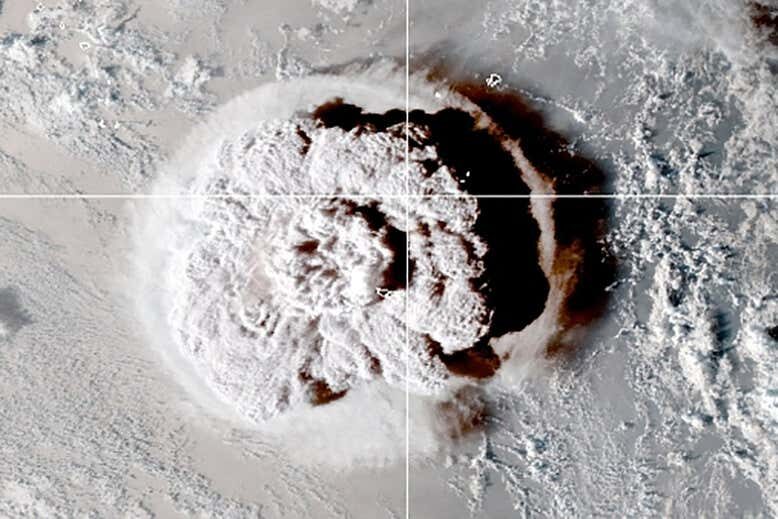
The massive explosion of Hunga Tonga-Hunga Ha'apai volcano in Tonga on Saturday was its most powerful eruption since AD 1100. The after-effects have been felt around the globe and the damage is still being assessed.
The volcano, located about 65 kilometres north of Tonga's capital, Nuku'alofa, exploded with violent force at 5:10pm local time on 15 January. Satellite images show a mushroom cloud of ash billowing 30 kilometres high and later sweeping more than 3000 kilometres west to Australia.
A sea level gauge at Nuku'alofa recorded a tsunami wave of 1.19 metres before it stopped recording, according to Hannah Power at the University of Newcastle in Australia. Videos posted to social media show waves crashing into houses in Tonga, and large waves also reached Japan, prompting evacuation orders, and Peru, where two people drowned at a beach.
The extent of destruction in Tonga is still uncertain because the country's main undersea phone and internet cable was damaged. New Zealand prime minister Jacinda Ardern said in a press conference on 16 January that she had received reports of boats and large boulders washed ashore in Nuku'alofa and damage to properties, but that there was no news from other coastal areas. No deaths have been reported at this stage.
A New Zealand air force plane was deployed on 17 January to assess the damage, but its findings haven't yet been reported.
Hunga Tonga-Hunga Ha'apai is 1.8 kilometres tall and 20 kilometres wide, but most of it is underwater, with only its top 100 metres poking out of the sea. It has been spewing ash intermittently and making small blast noises since 20 December.
The pressure wave generated by the explosion blasted through the atmosphere at more than 1000 kilometres per hour and was recorded crossing the US, UK and Europe. The resulting sonic boom was heard in nearby Fiji, in New Zealand and even in Alaska, over 9000 kilometres away.
The eruption also sparked almost 400,000 lightning bolts above the volcano as bits of ash and atmospheric ice particles bumped into each other and generated electrical charges.
"Given the potential for further volcanic activity, there is also the potential for further tsunamis to be generated," says Power.
Atmospheric sensors have detected large amounts of sulphur dioxide gas released by the eruption, which could cause acid rain to fall in Tonga and Fiji and affect crops and drinking water, says Shane Cronin at the University of Auckland in New Zealand. However, the amount of sulphur dioxide isn't enough to cause global cooling - an effect that was seen after the massive eruption of Mount Pinatubo in the Philippines in 1991, he says.
Cronin and his research team camped on Hunga Tonga-Hunga Ha'apai in 2015 and noticed that the surrounding coral reef was lifting up, suggesting that magma was building underneath the volcano and could cause an eruption in the near future.
Several small eruptions have occurred in the intervening years, probably as some of the growing pressure forced its way out of small fractures around the edge of the volcano, says Cronin. As the pressure built up further, it led to the breaking point on 15 January that caused the central part of the volcano to blow out, he says.
Satellite images show that that the above-water portion of the volcano is now almost completely obliterated. "You wouldn't be able to camp on it now," says Cronin.
His team found evidence of two previous mega-eruptions occurring on Hunga Tonga-Hunga Ha'apai in AD 1100 and AD 200, suggesting they occur roughly once every 1000 years.
The volcano has continued to erupt at a low level since 15 January and Cronin says he "wouldn't be surprised if there were a few more explosive events" in the coming days or weeks. However, they are unlikely to be as powerful as the initial explosion, he says.



Comment:
- Tsunami waves hit Tonga after massive underwater volcanic eruption sends debris and ash 20km into the sky
- 12km high ash cloud from Tongan volcanic eruption continues to spread
- Adapt 2030 Ice Age Report: An in-depth look at why Tonga erupted
Earth can unmake and remake itself at remarkable speeds. The now-destroyed island was just formed in 2015. It's arrogance on the part of the human race to think they have any control over the process.